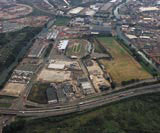Our Olympics bid stuck at starting blocks

Britain is already getting branding wrong for its Olympic 2012 bid, claims Pentagram partner David Hillman. His attack follows a Design Council warning that design must play a key role in planning and execution of the event if it is to succeed.
Hillman accuses the seven-yearold British Olympic Association logo, recently updated by Spencer du Bois to incorporate the Olympic rings, of presenting Britain as ‘being lost in the deep Dark Ages and run by the Royal Family’.
The marque, a stylised lion incorporating the Union Jack, is not contemporary enough, according to Hillman who adds, ‘We need imagery that says London is a modern city.’
Hillman’s outburst comes as the Design Council urges the Government to recognise the holistic role designers should play in the bid.
‘If designers are brought in at an early stage, they’ll be able to contribute far more on a strategic level than if they are parachuted in later to advise in an isolated way on individual matters such as logos or the shape of the stadium seats,’ says a Design Council spokeswoman.
Designers across a raft of disciplines are likely to benefit from the £17m bid launched last week by Prime Minister Tony Blair. The DCMS agrees that ‘creating an impressive image’ for the IOC is crucial to the capital’s Olympic bid, but says it is too early to say what kind of investment will be earmarked for branding and identity work.
Further details will emerge in the next three months, says a DCMS spokesman, following appointment of the Olympic chair, scheduled to be announced in late June.
Signage will be a particular challenge concurs TfL head of design Innes Ferguson, citing the need to cater for large amounts of visitors many of whose first language is not English.
‘We are going to need a simple system, easily accessible, with clear interchanges between different transport modes,’ he says. ‘That may include roundels on top of buildings with clear branding and plenty of clear visual prompts so people don’t need to be messing around with maps.’
However, Hillman claims the Government’s prevarication over whether or not to enter the race means design considerations won’t have the headstart required for a successful bid.
He highlights the case of Melbourne, which during its bid for the last games, dressed up the city as though it was already staging the event.
‘They put up banners and sculptures and revived their sports facilities so International Olympic Committee members could get a sense of what the city would feel like if it won the games. I can’t see that happening here.’
Hillman also stresses the need for the Olympic Village and associated buildings to be designed with future use in mind. ‘They need to be of a quality that ensures badly housed Londoners can move into them afterwards.’
London’s creaking transport system has also raised questions over the capital’s ability to cope with the influx of people an Olympic event would attract to the city, with successful completion of a crossrail system cited by some (although not the DCMS) as crucial to the bid.
-
Post a comment




